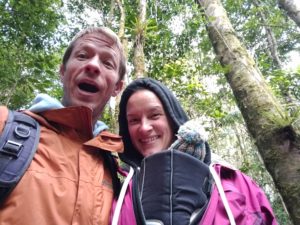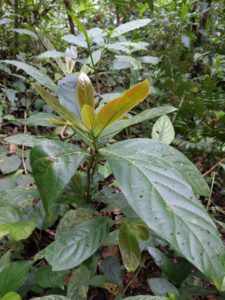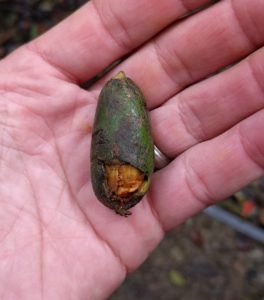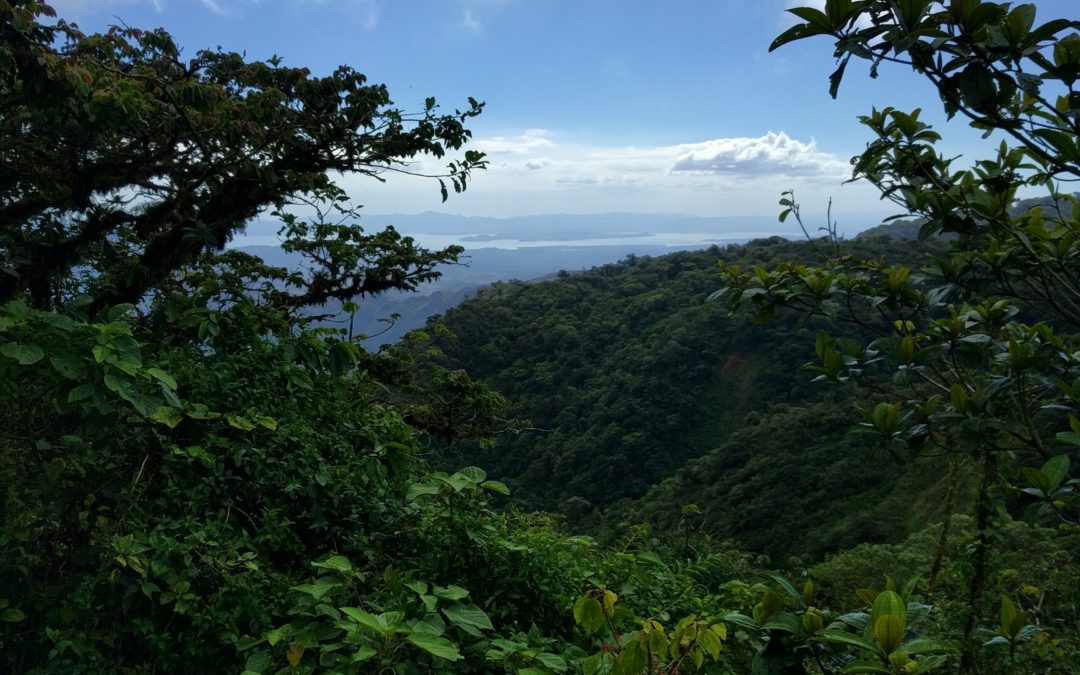Our guide through the Monteverde Cloud Forest Biological Reserve in the highlands of Costa Rica had just picked up a fallen orchid to show us when we heard a whistle. He put the orchid down and started walking briskly toward the whistle. We followed. He turned back to whisper, “They have found the Resplendent Quetzal.”
Soon we found other guides and other hikers choking the path and staring up into the canopy. Everyone talked with excitement. Seeing this bird is almost everyone’s grand goal in visiting the cloud forest.
The Quetzal (pronounced “ketsal”) is special in many ways to many people. It is half of the Aztec god Quetzalcoatl, a bird-serpent. It is the national bird of the country of Guatemala. And plainly to anyone on the planet, it is beautiful, it is resplendent indeed.

This is the bird we saw, as we saw it, perched majestically about forty feet off the forest floor. I was surprised to feel so impressed by it. Bigger than I expected, its colors were also brighter. The iridescence of its crown and the length of its tail feathers you can’t see in this photo, but they captivated me.

And yet, before seeing the bird all I’d been interested in was what the Quetzal ate.
The Wild Avocado
“Sometimes, particularly in the highlands of Guatemala, native guides will inform you that only where the Quetzal bird is found there you may find wild avocados, as this rare bird eats the fruit of some Perseas. Therefore we must explore the Quetzal country.” So wrote Eugenio Schieber and George Zentmyer in the 1972-73 Yearbook of the California Avocado Society. (Read their article, “Collecting Perseas in Central America and Mexico.”)
Schieber and Zentmyer were on a quest to find wild avocados in order to collect their seeds and use them as rootstock back in California. The hope was that these primitive avocados might be resistant to the fungus Phytophthora cinnamomi, which causes the disease called root rot. At the time, California avocado orchards were being thoroughly damaged by root rot.
As for me, I just wanted to see a wild avocado tree with my own two eyes, at all, for the first time. I love everything avocado — eating them, growing them, reading about them. Only I’d never seen them in their native habitat, which most botanists agree ranges from southern Mexico down through Costa Rica and possibly as far south as Peru.
Yet, a mere twenty steps into our hike that day I had spotted leaves that shouted avocado to me. I asked Kenneth — who was a local guide, having grown up in northern Costa Rica, despite the familiar name — if it was by chance an avocado. “Yes, it is. Avocados are one of the most common trees here.”

Then he pointed out a mature wild avocado tree. I couldn’t have wrapped my arms around the trunk, which shot vertically with no thick side branches for at least forty feet, at which point it started to spread and have foliage.

This was similar to almost all of the wild avocado trees I saw that day. This was the cloud forest, where clouds are ever present and there is over 100 inches of rain in a year, where trees reach — stretch! — for the top of the forest canopy in order to gather sunlight. Below them are flowering shrubs and vines. Attached to the trees, avocado and other, are epiphytes galore.
Epiphytes grow on the trunks and branches of the trees but do not use the trees for anything except structural support. They get all of their water and nutrients from the air and rain. Epiphytes I noticed on the wild avocado trees included orchids and bromeliads.

It was only a few more minutes into our hike when Kenneth spotted a wild avocado fruit on the ground and handed it to me.

It was recognizable as a kind of avocado, and yet it was extremely different from the cultivated varieties that we grow in our yards. The flesh was not much thicker than the skin, and the seed was proportionately huge. The entire fruit was only a little bigger than an acorn. Now I understood how the Quetzal could eat it whole.
The Quetzal and the Wild Avocado
As Kenneth explained, a Quetzal eats a couple of wild avocados whole and then perches on a branch for about 25 minutes, not moving, just digesting. The acids in its stomach remove the skin and flesh from the seed, and then the bird regurgitates the seed. Sometimes you’ll hear an avocado seed hit the ground as you’re walking through the forest, he said, and that’s how you can find the Resplendent Quetzal. Maybe that’s how someone first spotted this one.
I was watching the bird through Kenneth’s telescope when a seed popped out of its beak. But the Quetzal didn’t drop it. The bird rotated it 180 degrees and swallowed it again. “Kenneth! I just saw . . . !”
He said the bird does this to get more flesh off the seed. A minute later, I heard a nearby thud. “That was the seed,” he said.
If someone comes to Monteverde hoping to see the Resplendent Quetzal, they can’t find one, Kenneth told us. But if someone doesn’t care to see a Quetzal, they inevitably see three. Later that day, while hiking without Kenneth, we saw our second Quetzal perched over a suspension bridge. The next day, we saw our third.
Each Quetzal was gorgeous, but still my eyes during our hikes were searching for the wild avocado fruit they ate and the unimaginably large trees that bore them. Wild avocado trees were everywhere, Kenneth was right. The fruit, however, was nowhere. I never saw another one. That’s OK — they are for the Quetzals anyway, right? We have big fleshy ones at home for ourselves.
(Kenneth took this video of the Quetzal with my camera using his telescope.)
You might also like to read:
Among some of the oldest avocado trees in California, at The Huntington
How the Fuerte avocado really got its name
Growing avocados in Southern California
All of my Yard Posts are listed here.
Your support keeps my Yard Posts coming and the ads away. Thank you!




Everything about this post, I love. I was worried that the avocados were going to be a new discovery and blow our common ones out of the water, and this ecosystem would soon be pillaged. It was a happy ending, knowing there’s not much reason to bother either the Quetzal OR the native avocados.
Thank you for the lovely writing.
Thank you, Laurie Ann. I’m so grateful for the establishment of this reserve. And the history of setting aside this part of the cloud forest is fascinating; it involves Quakers from Alabama who migrated to the area and named it Monteverde about 70 years ago. Read a little more here: http://www.reservamonteverde.com/our-history.html
They report that megafauna are the only animals that can spread avocado seed and it turns out that it’s actually birds.
What a fabulous hike! The bird is gorgeous! Thank you for sharing it with us!
This is so interesting! I am amazed at how different the wild avocado is from our varieties. How blessed are you to see three Quetzal! I’m so happy you had this experience. Thank you for sharing it.
Cool and Interesting ! Thank you for your report. Question: Como se llama “wild avocado” en Costa Rica ?
Hi Nobuyo,
Thank you. Good question, but I’m sorry that I can’t recall the answer clearly, and I didn’t record it in my notes. It may have been “aguacatillo” but I can’t say for sure.
Very much enjoyed the article. Resplendent Quetzals however contrary to to what is stated in the article don’t quickly die when held in captivity. They’ve been successfully kept in 19 European zoos and numerous other collections world wide. They were first hand reared by the naturaralist Von Hagen in the 1930’s.Like a number of Trogonids they can be long lived in captivity, the R. Quetzal has lived for over twenty years in captivity and have been bred in captivity. I cared for a trio of resplendent quetzals in the 1960’s at Chester Zoo in the UK that were long lived even though the nutrition and maintenance was less understood than it is now.
Thank you so much for this, Bill. I’ll edit the post accordingly.